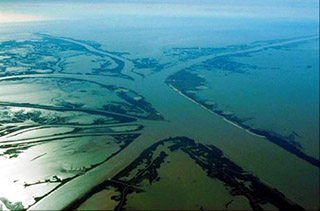Unusually high water conditions in the Mississippi River have contributed to accidents and deaths in recent weeks, and now something else: So much silt that deep-draft vessels inbound to New Orleans are getting narrow times for movement upriver based on highest tides.
Maritime groups have been issuing advisories, beginning Friday when the Associated Branch Pilots of the Port of New Orleans (known locally as the Bar Pilots) announced vessels should not have a freshwater deep draft of more than 45’ when transiting the Southwest Pass, the main channel for shipping, to mile 1.5 above the Head of Passes in the river. That was a reduction of 2’ from the previous 47’ maximum.
The pilots set new restrictions for all inbound vessels with a freshwater draft of 38’ or greater, including a seven-hour window for ship movement. Those seven hours begin five hours prior to high tide as posted on the National Oceanic and Atmospheric Administration’s web pages, and ends two hours after the posted high tide. There are no restrictions for outbound vessels or for inbound vessels with a draft less than 38’.
The latest crest at New Orleans was 15.64’ on July 29, down to 13.5’ Monday at the Army Corps of Engineers Carrollton gauge in the city. The pilots’ draft restrictions will likely remain in place until levels are 10’ and falling at Carrollton, the Big River Coalition advised its members on Monday.
Months of heavy rain across the river have kept levels high since March, and brought record river stage levels through July into August. The weather influences behind that extend over thousands of miles westward, to the appearance of unusually warm water in the Pacific Ocean known as El Niño, the Bar Pilots said in their notice.
“The ongoing weather pattern known as El Niño has impacted the Mississippi River through increased rains across the basin…with record stages often comes a record amount of shoaling,” the pilots’ notice said. That could affect shipping throughout the hemisphere, the pilots noted.
El Niño also causes drier conditions in the country of Panama. The Panama Canal Authority (PCA) recently reduced its maximum draft restriction to 39’ from 39’6”. The PCA expects that additional draft restrictions may also be necessary based on the present conditions and their experience during the strong El Niño pattern that prevailed in 1997-1998.




